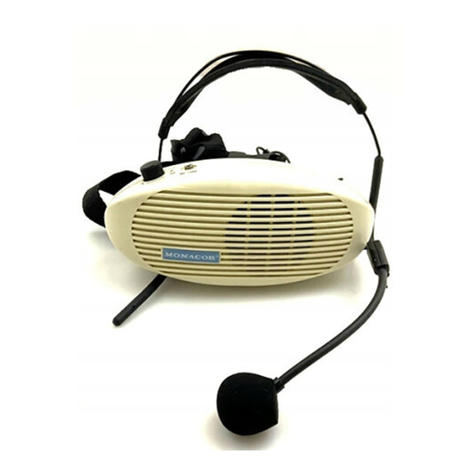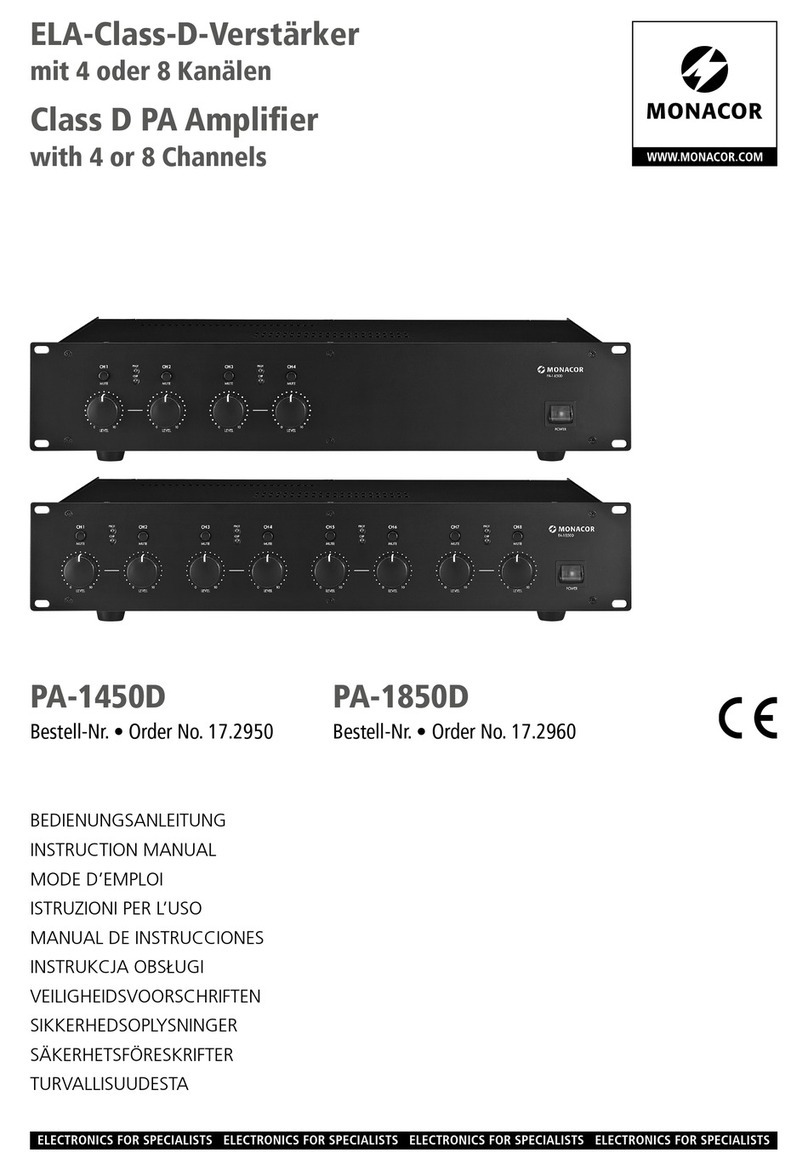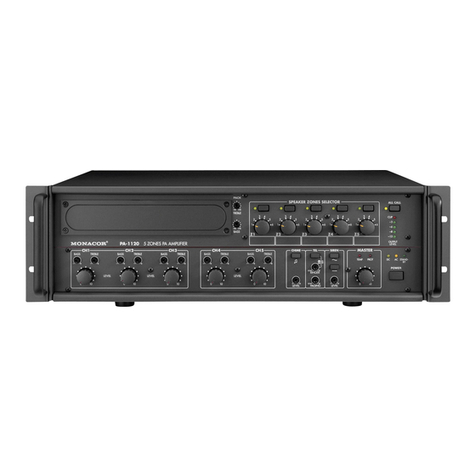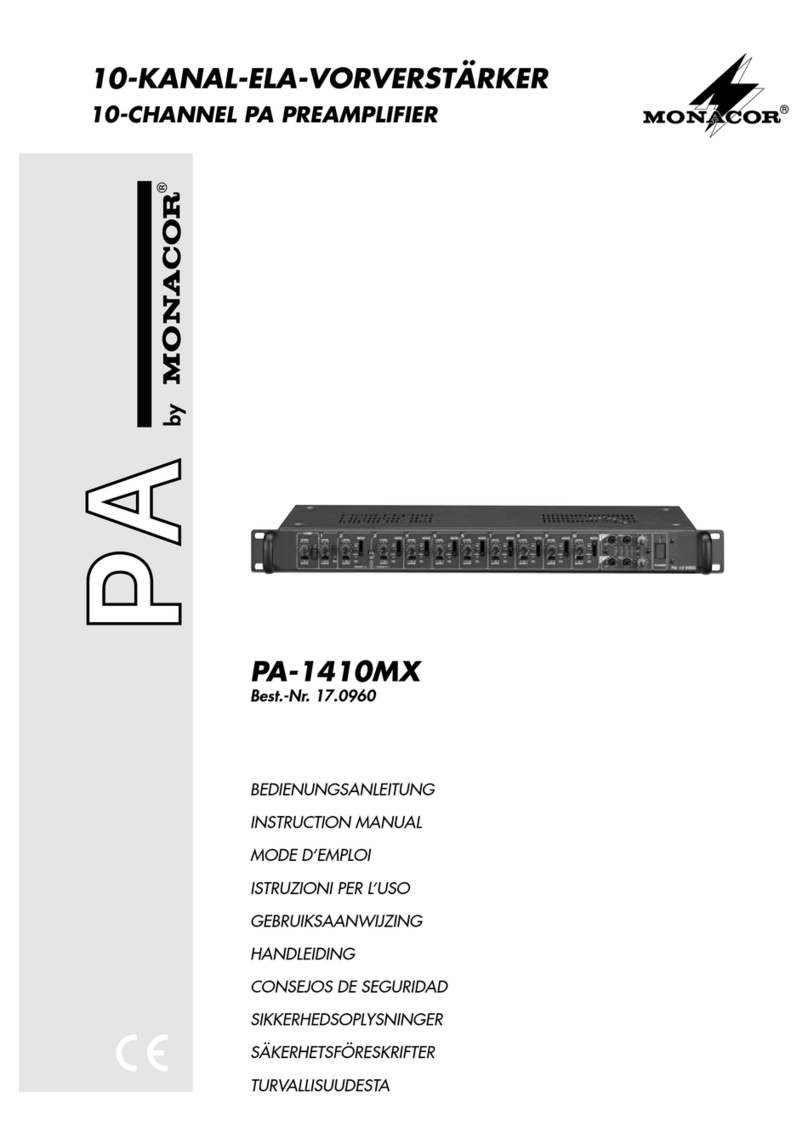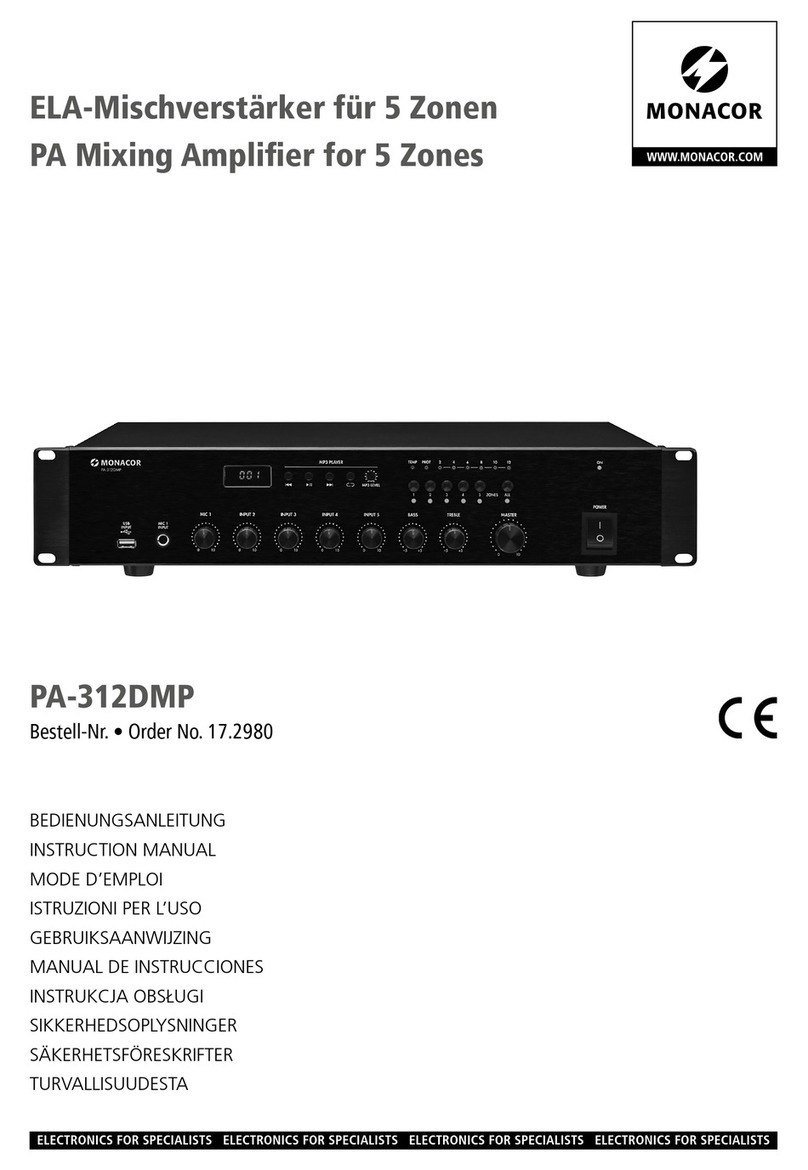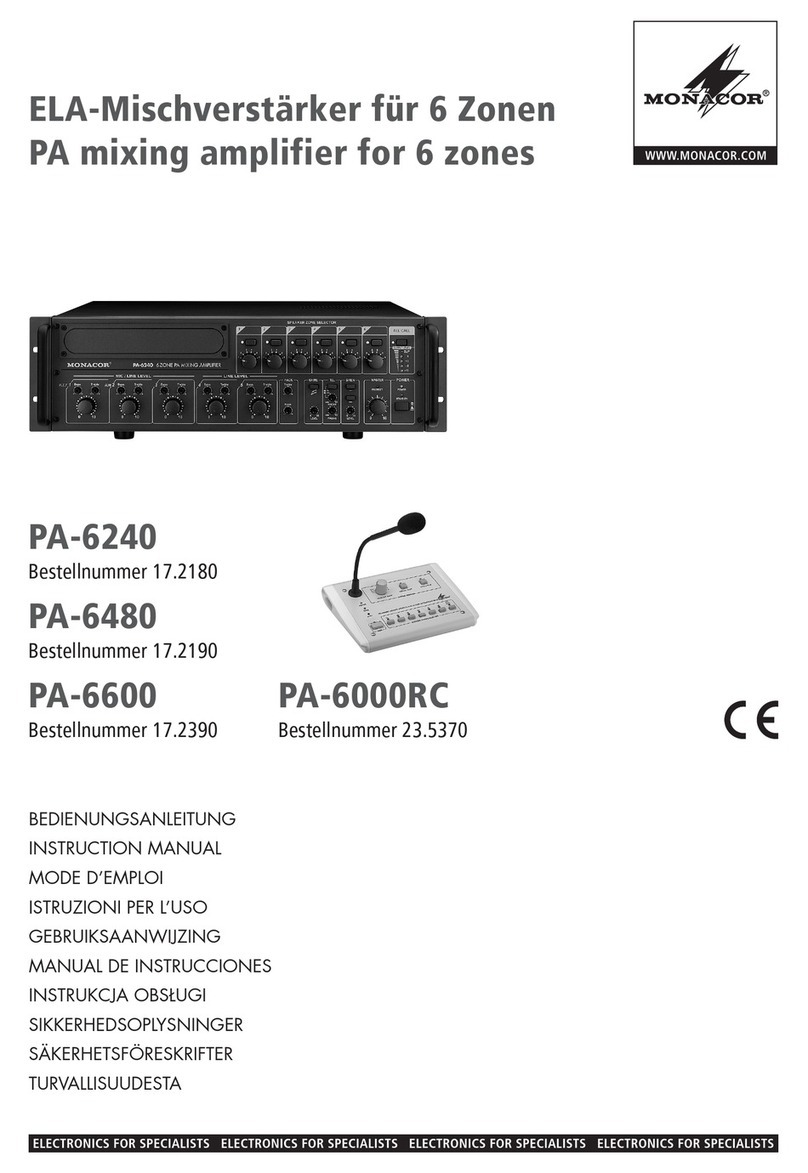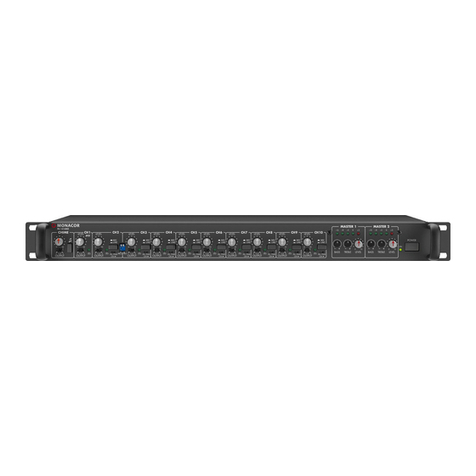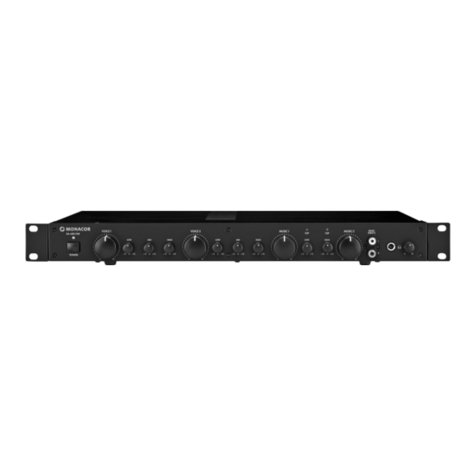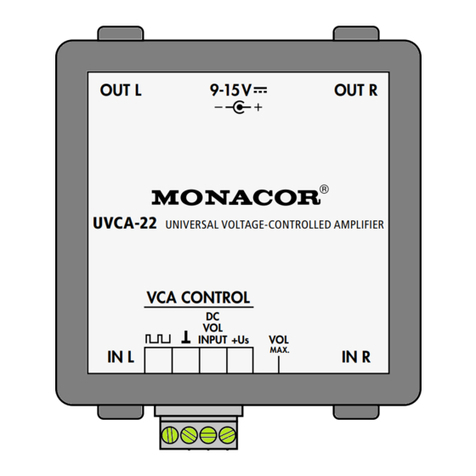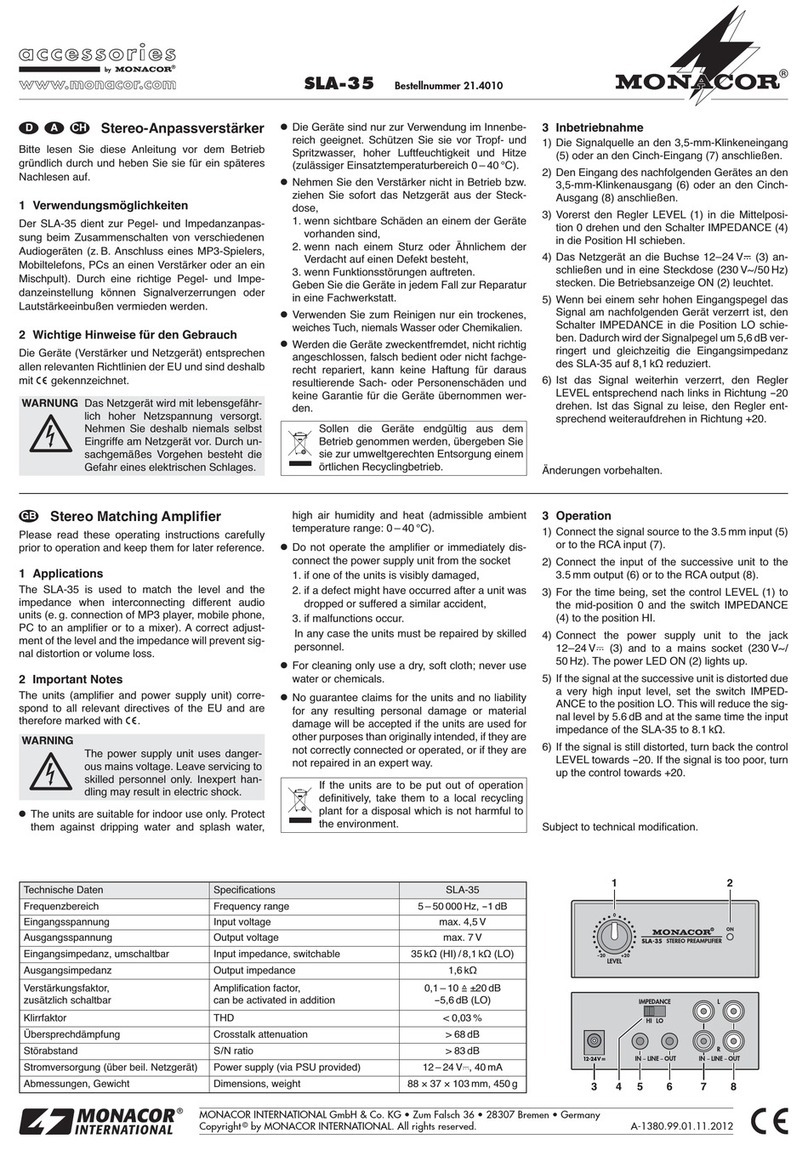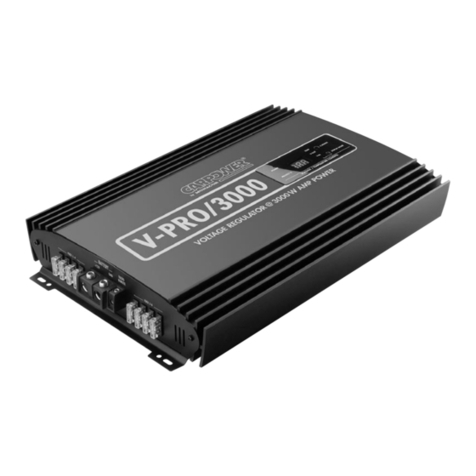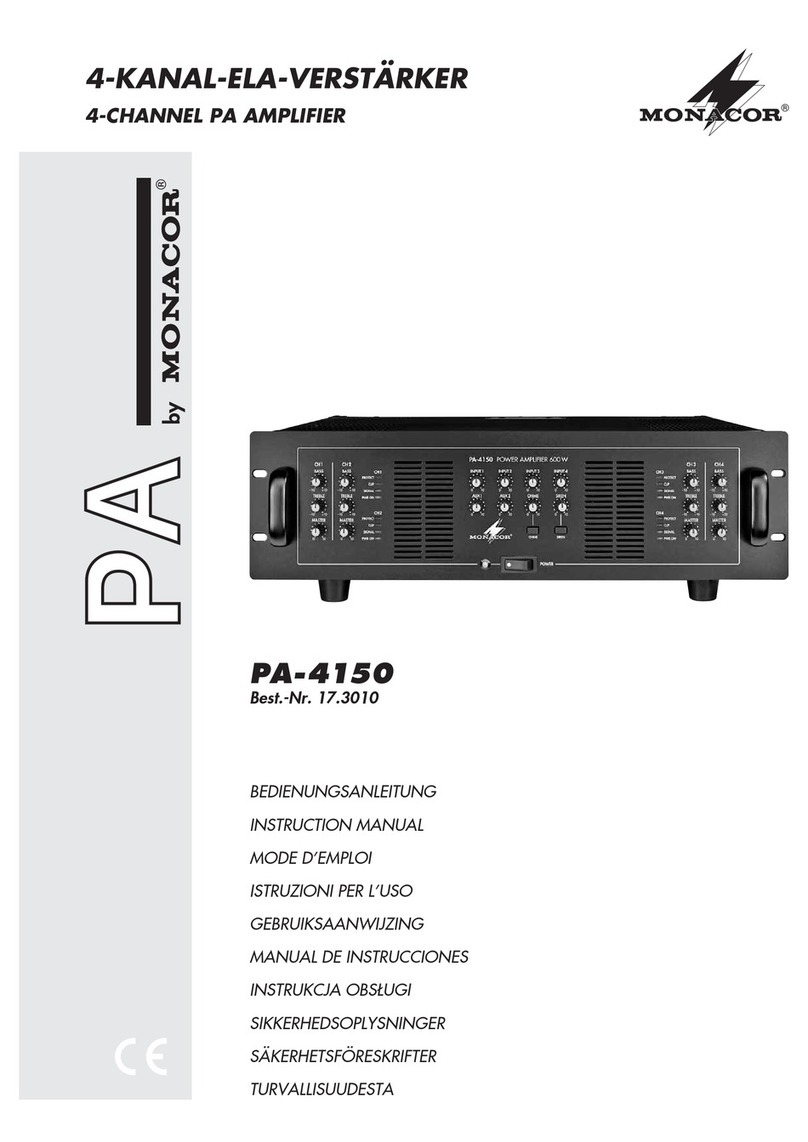Hinweis: Der Eingang CH2 darf jetzt nicht für
andere Eingangssignale benutzt werden, weil dieser
mit dem Eingang für das Kommandomikrofon paral-
lelgeschaltet ist.
1) Den Netzstecker aus der Steckdose ziehen, und
den Gehäusedeckel des Verstärkers sowie die
Blende (45) auf der Verstärkerrückseite ab-
schrauben.
2) Die 3polige Leitung des Anschlußmoduls vom
Anschluß AS903 (c) in die Buchse CN903 (c)
des Verstärkers stecken – siehe Lageplan auf
Seite 37.
3) Das Modul in die durch die Blende (45) freigege-
bene Aussparung einsetzen.
4) Die im Verstärker freiliegende, schwarz-rote
2polige Leitung (a) vom Anschluß AS801 in die
Buchse CN801 (a) des Moduls stecken.
5) Die abgeschirmte Leitung des Moduls vom
Anschluß AS802 (b) in die Buchse CN802 (b)
des Verstärkers stecken.
6) Die 6polige Leitung des Moduls vom Anschluß
AS901 (d) in die Buchse CN901 (d) des Verstär-
kers stecken.
7) Ist kein Digital-Message-Einschub PA-1120DM
eingebaut, die lose 10polige Leitung des Moduls
mit Kabelbindern befestigen.
Die Punkte 8) und 9) nur bei eingebautem Einschub
PA-1120DM durchführen:
8) Die 10polige Leitung des Moduls vom Anschluß
AS4-1 in die Buchse CN4-1 des Einschubs
stecken.
9) Um ein versehentliches Starten einer Durchsage
des Digital-Message-Speichers M6 zu verhin-
dern, ist die Brücke MS802 desAnschlußmoduls
auf OFF gesetzt. [Der Speicher M6 kann z.B. für
eine automatische Alarmdurchsage reserviert
sein, die nur über die Klemmen MESSAGE
FIRST PRIORITY (33) aktiviert werden soll.] Um
auch über das Kommandomikrofon PA-1120RC
die Durchsage des Speichers M6 abrufen zu
können, die Brücke in die Position ON setzen.
Nach dem Einbau des Anschlußmoduls das Mikro-
fon mit dem Modul verbinden und die Grundeinstel-
lungen vornehmen.
1) Über das beiliegende Verbindungskabel die
Buchse OUTPUT (54) mit der Buchse INPUTdes
Anschlußmoduls verbinden.
2) Zum Anschluß weiterer Mikrofone des Typs
PA-1120RC die Buchse LINK (53) am jeweils vor-
herigen Mikrofon oder die Buchse LINK am
Modul verwenden.
3) Beim Einsatz mehrerer Mikrofone des Typs
PA-1120RC an dem Mikrofon bzw. an den Mikro-
fonen, die Vorrang vor den übrigen erhalten sol-
len, den Schalter TALK (52) in die Position PRIO-
RITY schieben. Bei den übrigen Mikrofonen den
Schalter in die Position SLAVE schieben. Da-
durch kann während einer Durchsage von einem
Mikrofon mit Vorrang keine Durchsage von
einem Mikrofon ohne Vorrang erfolgen. (Bei
gleichwertigen Mikrofonen hat das zuerst akti-
vierte Mikrofon Vorrang.)
4) Um für das Kommandomikrofon bzw. für die
Kommandomikrofone 1. Priorität zu erhalten, die
Taste am Anschlußmodul drücken (Position PRI-
ORITY). Bei nicht gedrückter Taste (Position
SLAVE) ist 3. Priorität eingestellt.
5) Wird der Digital-Message-Einschub PA-1120DM
verwendet, mit dem Schalter DIGITAL MES-
SAGE (51) wählen, ob über das Kommandomi-
krofon gespeicherte Durchsagen abgerufen wer-
den können (Schalterposition ON) oder gesperrt
sind (Position OFF).
6) Wenn die Eingänge am Verstärker nicht ausrei-
chen, kann in die Buchsen AUX IN (55) ein Line-
Signal eingespeist werden (z.B. von einem CD-
Spieler Hintergrundmusik). Das Signal mit dem
Regler AUDIO OUT (56) gegenüber dem Mikro-
fonsignal ggf. abschwächen.
5.3 Geräte mit Line-Pegel/ Tonaufnahmegerät
Bis zu fünf Geräte mit Line-Pegel (z.B. CD-Spieler,
Kassettenrecorder) lassen sich an die Eingänge
CH1 bis CH3 (39) sowie CH4 und CH5 (38) an-
schließen (Ausnahmen: CH1 nicht benutzen beim
Betrieb des Tischmikrofons PA-1120PTT und CH2
nicht benutzen beim Betrieb des Kommandomikro-
fons PA-1120RC!).
1) Beim Anschluß der Eingänge CH1 bis CH3 den
dazugehörigen Regler GAIN (41) ganz nach links
in die Position „
-
10“ drehen. Die entsprechende
Taste PHANTOM POWER (40) nicht drücken.
2) Soll von den Eingängen CH1 bis CH3 einer Vor-
rang erhalten, den entsprechenden DIP-Schalter
MIC PRIORITY (44) in die Position ON stellen.
Die Eingänge CH1 bis CH3 haben immer Vor-
rang vor den Eingängen CH4 und CH5 (siehe
auch Kapitel 6).
3) Ein Tonaufnahmegerät kann an die Buchsen
REC (37) angeschlossen werden. Die Aufnah-
melautstärke ist vom Regler MASTER (21) und
den Zonenabschwächern (5) unabhängig.
5.4 Equalizer oder andere Geräte einschleifen
Zur Klangbeeinflussung läßt sich ein Equalizer oder
ein Effektgerät einschleifen.
1) Die Buchse PRE OUT (36) mit dem Eingang des
Equalizers bzw. des Effektgeräts verbinden.
2) Die Buchse AMP IN (35) mit dem Ausgang des
Equalizers bzw. des Effektgeräts verbinden.
5.5 Telefon- oder Nachtklingel
Eine Telefon- oder Nachtklingel kann bei Bedarf
über die ELA-Anlage ertönen (z.B. während eines
nächtlichen Kontrollrundgangs).
1) Das Signal für die Klingel (z. B. 8V/50 Hz) auf die
Klemmen NIGHT RINGER (29) geben.
2) Die Taste TEL (14) drücken.
3) Die Klingel auslösen, und mit dem Regler RIN-
GER (16) die Lautstärke des vom Verstärker
erzeugten Rufzeichens einstellen.
4) Die Ruffunktion mit der Taste TEL je nach Bedarf
ein- oder ausschalten.
Hinweis: Die Klingel hat 4. (niedrigste) Priorität.
5.2.2 Zone paging microphone PA-1120RC
The zone paging microphone PA-1120RC (fig. 4)
available as a separate accessory has especially
been designed for this amplifier. Up to 10 zone
paging microphones can be connected when the
connecting cables are short, in case of longer cables
(up to 100m), max. three microphones. For opera-
tion, the connecting module supplied with the micro-
phone must be installed into the amplifier first.
Installation must be made by skilled personnel only!
Note: The input CH2 must not be used for other
input signals now as it is connected in parallel with
the input of the zone paging microphone.
1) Disconnect the mains plug from the mains socket
and unscrew the housing cover of the amplifier
and the cover plate (45) on the rear side of the
amplifier.
2) Connect the 3-pole line of the connecting module
from connectionAS903 (c) to the jack CN903 (c)
of the amplifier – see general layout on page 37.
3) Install the module into the opening uncovered by
the cover plate (45).
4) Connect the loose black and red 2-pole line (a) in
the amplifier from the connection AS801 to the
jack CN810 (a) of the module.
5) Connect the screened line of the module from the
connection AS802 (b) to the jack CN802 (b) of
the amplifier.
6) Connect the 6-pole line of the module from the
connection AS901 (d) to the jack CN901 (d) of
the amplifier.
7) If no digital message insertion PA-1120DM has
been installed, fix the loose 10-pole line of the
module by means of cable ties.
Only carry out steps 8) and 9) with the insertion
PA-1120DM installed:
8) Connect the 10-pole line of the module from the
connection AS4-1 to the jack CN4-1 of the inser-
tion.
9) To prevent unintentional start of an announce-
ment from the digital message storage M6, the
jumper MS802 of the connecting module is set to
OFF. [The storage M6 may be reserved e.g. for
an automatic alarm announcement which is to be
activated only via the terminals MESSAGE
FIRST PRIORITY (33).] To be able to call the
announcement of the storage M6 also via the
zone paging microphone PA-1120RC, set the
jumper to the position ON.
After installing the module, connect the microphone
to the module and make the basic adjustments.
1) Connect the jack OUTPUT (54) to the jack INPUT
of the module via the supplied cable.
2) When connecting further microphones of the type
PA-1120RC, use the jack LINK (53) on the re-
spective previous microphone or the jack LINK
on the module.
3) When using several microphones of the type
PA-1120RC, set the TALK switch (52) to the posi-
tion PRIORITY on the microphone or on the
microphones which are to take priority over the
others. On the other microphones, set the switch
to the position SLAVE. Thus, while an announce-
ment is made by a microphone of priority, no
announcement can be made by a microphone
without priority. (In case of microphones of the
same priority, the first activated microphone will
take priority.)
4) To obtain first priority for the zone paging micro-
phone or the zone paging microphones, press
the button on the connecting module (position
PRIORITY). If the button is not pressed (position
SLAVE), 3rd rank priority is adjusted.
5) When using the digital message insertion
PA-1120DM, use the switch DIGITAL MESSAGE
(51) to determine if announcements can be
called that have been stored via the zone paging
microphone (switch position ON) or if they are
locked (position OFF).
6) If the inputs on the amplifier do not suffice, a line
input signal can be fed into the jacksAUX IN (55)
[e.g. background music from a CD player]. If
required, attenuate the signal as compared to the
microphone signal by means of the control
AUDIO OUT (56).
5.3 Units with line level/sound recording
unit
Up to five units with line level (e.g. CD players, tape
recorders) can be connected to the inputs CH1 to
CH3 (39) as well as to CH4 and CH5 (38). (Excep-
tions: Do not use CH1 when operating the desk
microphone PA-1120PTT and do not use CH2 when
operating the zone paging microphone PA-1120RC!)
1) When connecting the inputs CH1 to CH3, turn
the corresponding GAIN control (41) fully to the
left to position “
-
10”. Do not press the cor-
responding button PHANTOM POWER (40).
2) If one of the inputs CH 1 to CH3 is to take priority,
set the corresponding DIP switch MIC PRIORITY
(44) to the position ON. The inputs CH1 to CH3
always take priority over the inputs CH4 and
CH5 (also see chapter 6).
3) A sound recording unit can be connected to the
jacks REC (37). The recording volume depends
on the MASTER control (21) and the zone
attenuators (5).
5.4 Inserting equalizers or other units
To affect the sound, an equalizer or an effect unit
can be inserted.
1) Connect the jack PRE OUT (36) to the input of
the equalizer or the effect unit.
2) Connect the jack AMP IN (35) to the output of the
equalizer or the effect unit.
5.5 Telephone or night bell
If required, a telephone or night bell may sound via
the PA system (e.g. during a nightly inspection
round).
1) Feed the signal for the bell (e. g. 8V/50 Hz) to the
terminals NIGHT RINGER (29).
2) Press the button TEL (14).
3) Trigger the bell, and adjust the volume of the ring-
ing tone generated by the amplifier by means of
the control RINGER (16).
8
GB
D
A
CH
